

Compact Muon Solenoid
LHC, CERN
| CMS-TOP-17-008 ; CERN-EP-2018-310 | ||
| Measurement of the top quark mass in the all-jets final state at $\sqrt{s} = $ 13 TeV and combination with the lepton+jets channel | ||
| CMS Collaboration | ||
| 27 December 2018 | ||
| Eur. Phys. J. C 79 (2019) 313 | ||
| Abstract: A top quark mass measurement is performed using 35.9 fb$^{-1}$ of LHC proton-proton collision data collected with the CMS detector at $\sqrt{s} = $ 13 TeV. The measurement uses the $ \mathrm{t\bar{t}} $ all-jets final state. A kinematic fit is performed to reconstruct the decay of the $ \mathrm{t\bar{t}} $ system and suppress the multijet background. Using the ideogram method, the top quark mass ($ {m_{\mathrm{t}}} $) is determined, simultaneously constraining an additional jet energy scale factor (JSF). The resulting value of ${m_{\mathrm{t}}} =$ 172.34 $\pm$ 0.20 (stat+JSF) $\pm$ 0.70 (syst) GeV is in good agreement with previous measurements. In addition, a combined measurement that uses the $ \mathrm{t\bar{t}} $ lepton+jets and all-jets final states is presented, using the same mass extraction method, and provides an $ {m_{\mathrm{t}}} $ measurement of 172.26 $\pm$ 0.07 (stat+JSF) $\pm$ 0.61 (syst) GeV. This is the first combined $ {m_{\mathrm{t}}} $ extraction from the lepton+jets and all-jets channels through a single likelihood function. | ||
| Links: e-print arXiv:1812.10534 [hep-ex] (PDF) ; CDS record ; inSPIRE record ; HepData record ; CADI line (restricted) ; | ||
| Figures | |
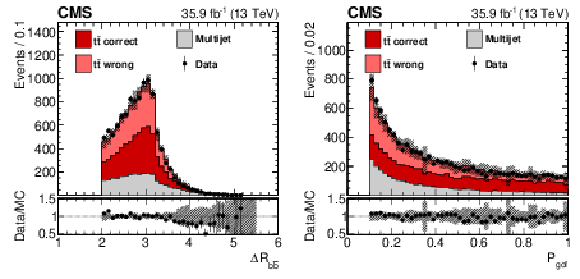
png pdf |
Figure 1:
The $ {\Delta R(\mathrm{b\bar{b}})} $ (left) and $ {P_\text {gof}} $ (right) distributions of data compared to simulated signal and the multijet background estimate. The hashed bands represent the total uncertainty in the complete prediction. The lower panels show the ratio of data and prediction. |
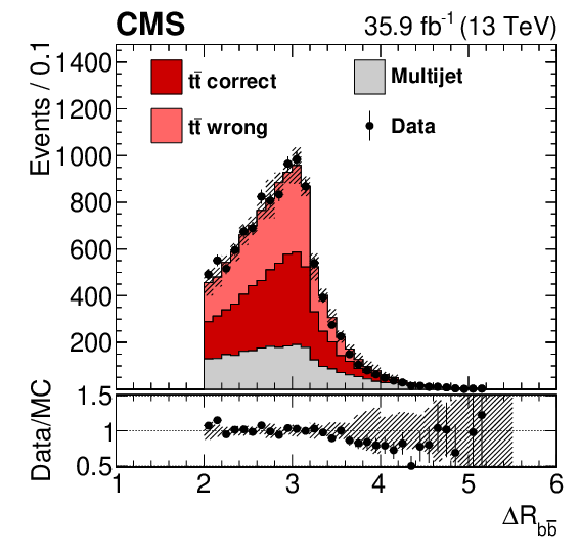
png pdf |
Figure 1-a:
The $ {\Delta R(\mathrm{b\bar{b}})} $ distribution of data compared to simulated signal and the multijet background estimate. The hashed bands represent the total uncertainty in the complete prediction. The lower panel shows the ratio of data and prediction. |
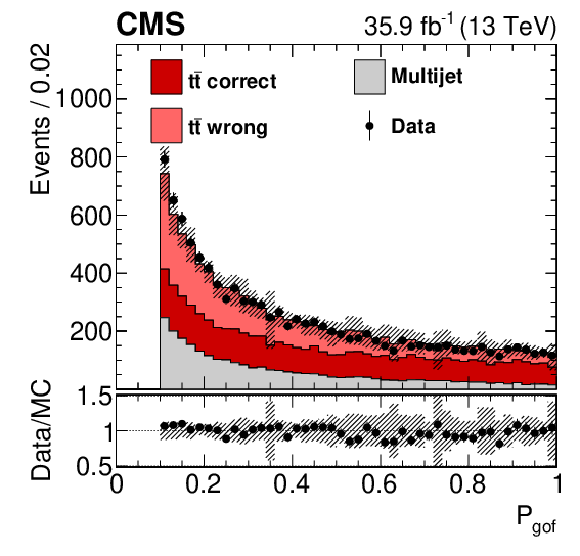
png pdf |
Figure 1-b:
The $ {P_\text {gof}} $ distribution of data compared to simulated signal and the multijet background estimate. The hashed bands represent the total uncertainty in the complete prediction. The lower panel shows the ratio of data and prediction. |
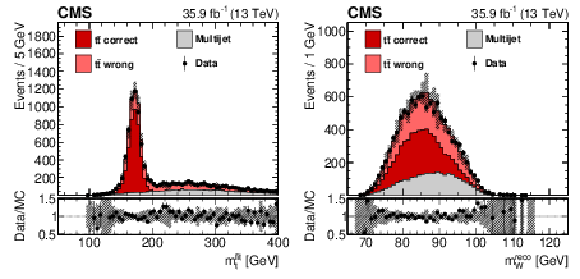
png pdf |
Figure 2:
The fitted top quark mass (left) and reconstructed W boson mass (right) distributions of data compared to simulated signal and the multijet background estimate. The shown reconstructed W boson mass is the average mass of the two W bosons in the event. The hashed bands represent the total uncertainty in the prediction. The lower panels show the ratio of data and prediction. |

png pdf |
Figure 2-a:
The fitted top quark mass distribution of data compared to simulated signal and the multijet background estimate. The lower panel shows the ratio of data and prediction. |
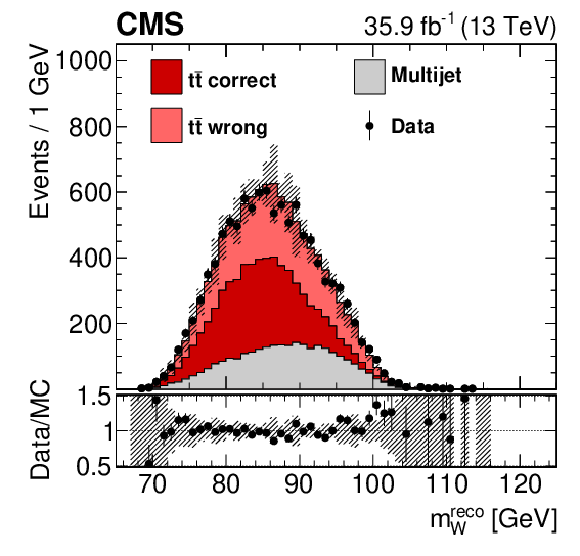
png pdf |
Figure 2-b:
The reconstructed W boson mass distribution of data compared to simulated signal and the multijet background estimate. The shown reconstructed W boson mass is the average mass of the two W bosons in the event. The hashed bands represent the total uncertainty in the prediction. The lower panel shows the ratio of data and prediction. |

png pdf |
Figure 3:
Difference between extracted and generated top quark masses (upper panel) and JSFs (lower panel) for different input masses and JSFs after the calibration in the all-jets channel. The values are extracted using the 2D method. |

png pdf |
Figure 4:
Difference between extracted and generated top quark masses (upper panel) and JSFs (lower panel) for different input masses and JSFs after the single-channel calibrations for the combined measurement. The values are extracted using the 2D method. |

png pdf |
Figure 5:
Likelihood contours for $-2\Delta \ln {\mathcal {L}} =$ 2.3, corresponding to the 68% confidence level, in the ${m_{{\mathrm {t}}}} - {\text {JSF}}$ plane (upper panel) and the likelihood profiles for the top quark mass (lower panel), where the level corresponding to one standard deviation ($\sigma $) is indicated. The hybrid measurement results for the all-jets and lepton+jets channels, as well as for the combination, are shown. |
| Tables | |

png pdf |
Table 1:
List of systematic uncertainties for the all-jets channel. The signs of the shifts ($\delta x = x_\text {variation} - x_\text {nominal}$) correspond to the $+1$ standard deviation variation of the systematic uncertainty source. For linear sums of the uncertainty groups, the relative signs have been considered. Shifts determined using dedicated samples for the systematic variation are displayed with the corresponding statistical uncertainty. |

png pdf |
Table 2:
List of systematic uncertainties for the combined mass extraction. The signs of the shifts ($\delta x = x_\text {variation} - x_\text {nominal}$) correspond to the $+1$ standard deviation variation of the systematic uncertainty source. For linear sums of the uncertainty groups, the relative signs have been considered. Shifts determined using dedicated samples for the systematic variation are displayed with the corresponding statistical uncertainty. |

png pdf |
Table 3:
Comparison of the hybrid mass uncertainties for the all-jets and lepton+jets [17] channels, as well as the combination. The signs of the shifts follow the convention of Tables 1 and 2. |
| Summary |
|
A measurement of the top quark mass ($ {m_{\mathrm{t}}} $) using the all-jets final state is presented. The analyzed data set was collected by the CMS experiment in proton-proton collisions at $\sqrt{s}=$ 13 TeV that correspond to an integrated luminosity of 35.9 fb$^{-1}$ . The kinematic properties in each event are reconstructed using a constrained fit that assumes a $ \mathrm{t\bar{t}} $ hypothesis, which suppresses the dominant multijet background and improves the mass resolution. The value of $ {m_{\mathrm{t}}} $ and an additional jet energy scale factor (JSF) are extracted using the ideogram method, which uses the likelihood of the values of $ {m_{\mathrm{t}}} $ and JSF in each event to determine these parameters. The resulting $ {m_{\mathrm{t}}} $ is measured to be 172.34 $\pm$ 0.20 (stat+JSF) $\pm$ 0.70 (syst) GeV. This is in good agreement with previous CMS results obtained at $\sqrt{s} = $ 7, 8, and 13 TeV. The modeling uncertainties are larger than in the previous measurements at lower center-of-mass energies because of the use of new alternative color reconnection models that were not previously available. |
| References | ||||
| 1 | CDF Collaboration | Observation of top quark production in $ \bar{p}p $ collisions | PRL 74 (1995) 2626 | hep-ex/9503002 |
| 2 | D0 Collaboration | Observation of the top quark | PRL 74 (1995) 2632 | hep-ex/9503003 |
| 3 | The ALEPH, CDF, D0, DELPHI, L3, OPAL, SLD Collaborations, the LEP Electroweak Working Group, the Tevatron Electroweak Working Group, and the SLD electroweak and heavy flavour groups | Precision Electroweak Measurements and Constraints on the Standard Model | technical report | 1012.2367 |
| 4 | M. Baak et al. | The electroweak fit of the standard model after the discovery of a new boson at the LHC | EPJC 72 (2012) 2205 | 1209.2716 |
| 5 | M. Baak et al. | The global electroweak fit at NNLO and prospects for the LHC and ILC | EPJC 74 (2014) 3046 | 1407.3792 |
| 6 | G. Degrassi et al. | Higgs mass and vacuum stability in the standard model at NNLO | JHEP 08 (2012) 1 | 1205.6497 |
| 7 | F. Bezrukov, M. Y. Kalmykov, B. A. Kniehl, and M. Shaposhnikov | Higgs boson mass and new physics | JHEP 10 (2012) 140 | 1205.2893 |
| 8 | DELPHI Collaboration | Measurement of the mass and width of the W boson in $ {\rm e}^{+}{\rm e}^{-} $ collisions at $ \sqrt{s} = $ 161 -- 209 GeV | EPJC 55 (2008) 1 | 0803.2534 |
| 9 | CMS Collaboration | Measurement of the top-quark mass in $ \mathrm{t\bar{t}} $ events with lepton+jets final states in $ {\mathrm{p}}{\mathrm{p}} $ collisions at $ \sqrt{s}= $ 7 TeV | JHEP 12 (2012) 105 | CMS-TOP-11-015 1209.2319 |
| 10 | CDF Collaboration | Measurement of the top-quark mass in the all-hadronic channel using the full CDF data set | PRD 90 (2014) 091101 | 1409.4906 |
| 11 | CMS Collaboration | Measurement of the top-quark mass in all-jets $ \mathrm{t\bar{t}} $ events in pp collisions at $ \sqrt{s} = $ 7 TeV | EPJC 74 (2014) 2758 | CMS-TOP-11-017 1307.4617 |
| 12 | CMS Collaboration | Measurement of the top quark mass using proton-proton data at $ {\sqrt{s}} = $ 7 and 8 TeV | PRD 93 (2016) 072004 | CMS-TOP-14-022 1509.04044 |
| 13 | ATLAS Collaboration | Measurement of the top-quark mass in the fully hadronic decay channel from ATLAS data at $ \sqrt{s}=$ 7 TeV | EPJC 75 (2015) 158 | 1409.0832 |
| 14 | ATLAS Collaboration | Top-quark mass measurement in the all-hadronic $ \mathrm{t\bar{t}} $ decay channel at $ \sqrt{s}= $ 8 TeV with the ATLAS detector | JHEP 09 (2017) 118 | 1702.07546 |
| 15 | ATLAS Collaboration | Measurement of the top quark mass in the $ t\bar{t}\to $ lepton+jets channel from $ \sqrt{s}= $ 8 TeV ATLAS data and combination with previous results | Submitted to EPJC | 1810.01772 |
| 16 | CDF and D0 Collaborations | Combination of CDF and D0 results on the mass of the top quark using up 9.7 fb$^{-1} $ at the Tevatron | FERMILAB-CONF-16-298-E | 1608.01881 |
| 17 | CMS Collaboration | Measurement of the top quark mass with lepton+jets final states using $ \mathrm {p} \mathrm {p} $ collisions at $ \sqrt{s}= $ 13 TeV | EPJC 78 (2018) 891 | CMS-TOP-17-007 1805.01428 |
| 18 | CMS Collaboration | The CMS trigger system | JINST 12 (2017) P01020 | CMS-TRG-12-001 1609.02366 |
| 19 | CMS Collaboration | Particle-flow reconstruction and global event description with the CMS detector | JINST 12 (2017) P10003 | CMS-PRF-14-001 1706.04965 |
| 20 | M. Cacciari, G. P. Salam, and G. Soyez | The anti-$ {k_{\mathrm{T}}} $ jet clustering algorithm | JHEP 04 (2008) 063 | 0802.1189 |
| 21 | M. Cacciari, G. P. Salam, and G. Soyez | FastJet user manual | EPJC 72 (2012) 1896 | 1111.6097 |
| 22 | M. Cacciari and G. P. Salam | Dispelling the $ N^{3} $ myth for the $ k_{\rm t} $ jet-finder | PLB 641 (2006) 57 | hep-ph/0512210 |
| 23 | CMS Collaboration | Jet energy scale and resolution in the CMS experiment in pp collisions at 8 TeV | JINST 12 (2017) P02014 | CMS-JME-13-004 1607.03663 |
| 24 | CMS Collaboration | Jet algorithms performance in 13 TeV data | CMS-PAS-JME-16-003 | CMS-PAS-JME-16-003 |
| 25 | CMS Collaboration | The CMS experiment at the CERN LHC | JINST 3 (2008) S08004 | CMS-00-001 |
| 26 | CMS Collaboration | Identification of heavy-flavour jets with the CMS detector in pp collisions at 13 TeV | JINST 13 (2018) P05011 | CMS-BTV-16-002 1712.07158 |
| 27 | P. Nason | A new method for combining NLO QCD with shower Monte Carlo algorithms | JHEP 11 (2004) 040 | hep-ph/0409146 |
| 28 | S. Frixione, P. Nason, and C. Oleari | Matching NLO QCD computations with parton shower simulations: the POWHEG method | JHEP 11 (2007) 070 | 0709.2092 |
| 29 | S. Alioli, P. Nason, C. Oleari, and E. Re | A general framework for implementing NLO calculations in shower Monte Carlo programs: the POWHEG BOX | JHEP 06 (2010) 043 | 1002.2581 |
| 30 | NNPDF Collaboration | Parton distributions for the LHC Run II | JHEP 04 (2015) 040 | 1410.8849 |
| 31 | T. Sjostrand, S. Mrenna, and P. Z. Skands | A Brief Introduction to PYTHIA 8.1 | CPC 178 (2008) 852 | 0710.3820 |
| 32 | P. Skands, S. Carrazza, and J. Rojo | Tuning PYTHIA 8.1: the Monash 2013 Tune | EPJC 74 (2014) 3024 | 1404.5630 |
| 33 | CMS Collaboration | Investigations of the impact of the parton shower tuning in PYTHIA 8 in the modelling of $ \mathrm{t\overline{t}} $ at $ \sqrt{s}= $ 8 and 13 TeV | CMS-PAS-TOP-16-021 | CMS-PAS-TOP-16-021 |
| 34 | GEANT4 Collaboration | GEANT4---a simulation toolkit | NIMA 506 (2003) 250 | |
| 35 | M. Czakon and A. Mitov | Top++: A program for the calculation of the top-pair cross-section at hadron colliders | CPC 185 (2014) 2930 | 1112.5675 |
| 36 | ATLAS and CMS Collaborations | Jet energy scale uncertainty correlations between ATLAS and CMS at 8 TeV | ATL-PHYS-PUB-2015-049, CMS-PAS-JME-15-001 | |
| 37 | CMS Collaboration | Measurement of the inelastic proton-proton cross section at $ \sqrt{s}= $ 13 TeV | JHEP 07 (2018) 161 | CMS-FSQ-15-005 1802.02613 |
| 38 | T. Sjostrand, S. Mrenna, and P. Skands | PYTHIA 6.4 physics and manual | JHEP 05 (2006) 026 | hep-ph/0603175 |
| 39 | M. Bahr et al. | Herwig++ physics and manual | EPJC 58 (2008) 639 | 0803.0883 |
| 40 | DELPHI Collaboration | A study of the b-quark fragmentation function with the DELPHI detector at LEP I and an averaged distribution obtained at the Z Pole | EPJC 71 (2011) 1557 | 1102.4748 |
| 41 | ALEPH Collaboration | Study of the fragmentation of b quarks into B mesons at the Z peak | PLB 512 (2001) 30 | hep-ex/0106051 |
| 42 | Particle Data Group | Review of particle physics | CPC 40 (2016) 100001 | |
| 43 | M. Czakon, D. Heymes, and A. Mitov | High-precision differential predictions for top-quark pairs at the LHC | PRL 116 (2016) 082003 | 1511.00549 |
| 44 | CMS Collaboration | Measurement of differential cross sections for top quark pair production using the lepton+jets final state in proton-proton collisions at 13 TeV | PRD 95 (2017) 092001 | CMS-TOP-16-008 1610.04191 |
| 45 | CMS Collaboration | Measurement of normalized differential $ \mathrm{t}\overline{\mathrm{t}} $ cross sections in the dilepton channel from pp collisions at $ \sqrt{s}= $ 13 TeV | JHEP 04 (2018) 060 | CMS-TOP-16-007 1708.07638 |
| 46 | J. R. Christiansen and P. Z. Skands | String formation beyond leading colour | JHEP 08 (2015) 003 | 1505.01681 |
| 47 | S. Argyropoulos and T. Sjostrand | Effects of color reconnection on $ t\bar{t} $ final states at the LHC | JHEP 11 (2014) 043 | 1407.6653 |
| 48 | J. Alwall et al. | The automated computation of tree-level and next-to-leading order differential cross sections, and their matching to parton shower simulations | JHEP 07 (2014) 079 | 1405.0301 |
| 49 | R. Frederix and S. Frixione | Merging meets matching in MC@NLO | JHEP 12 (2012) 061 | 1209.6215 |
| 50 | ATLAS Collaboration | Measurement of the top quark mass in the $ \mathrm{t\bar{t}}\to $ dilepton channel from $ \sqrt{s}= $ 8 TeV ATLAS data | PLB 761 (2016) 350 | 1606.02179 |

|
Compact Muon Solenoid LHC, CERN |

|

|

|

|

|

|